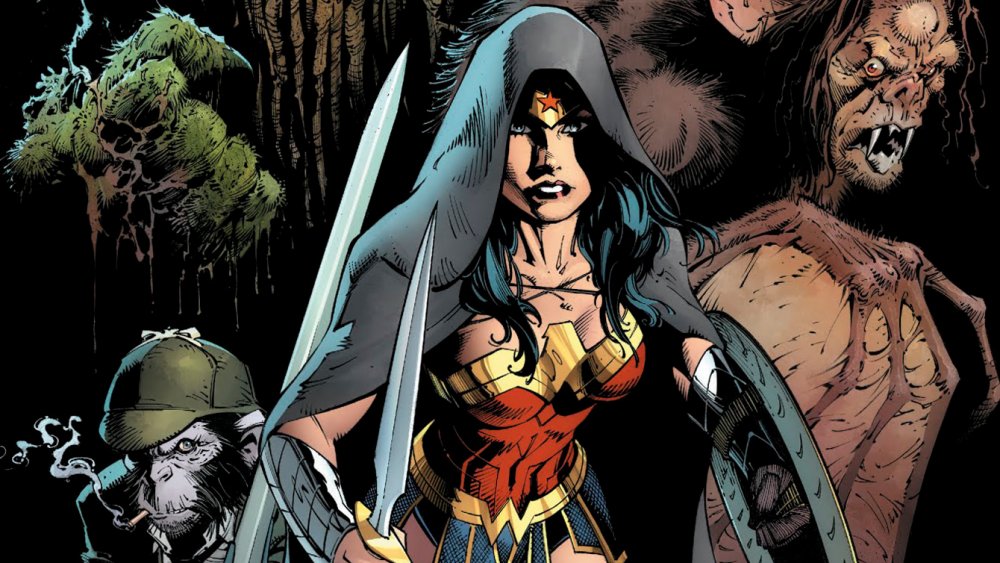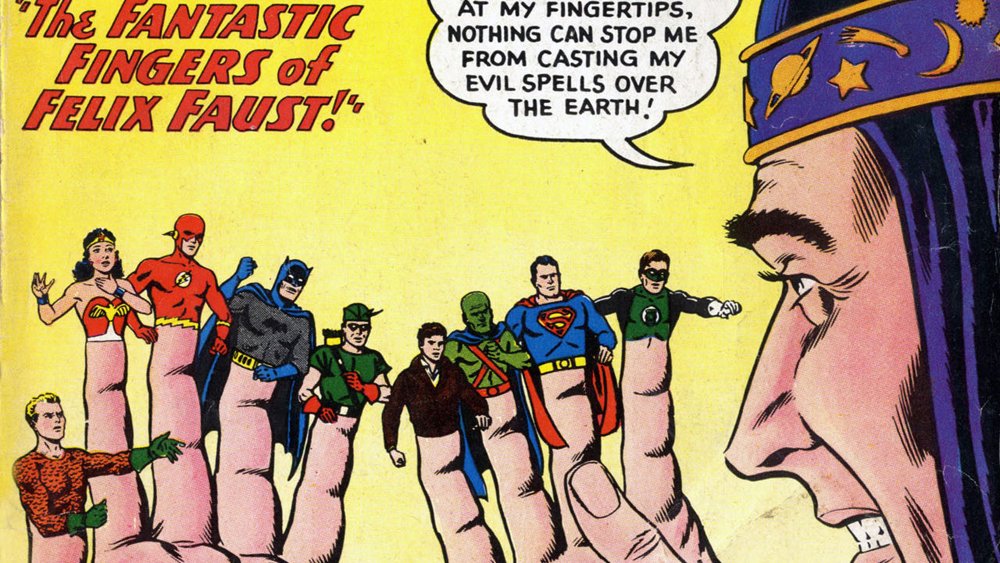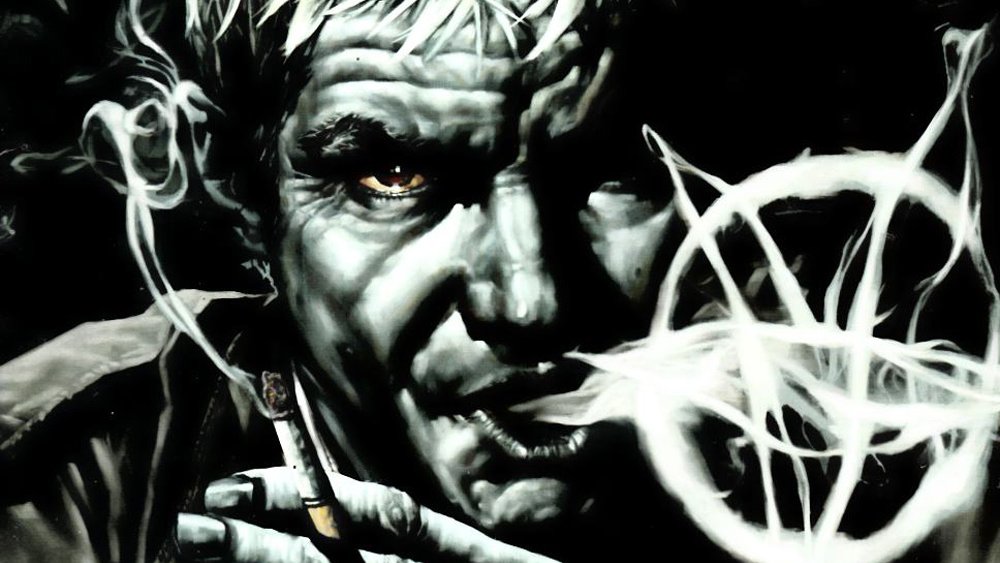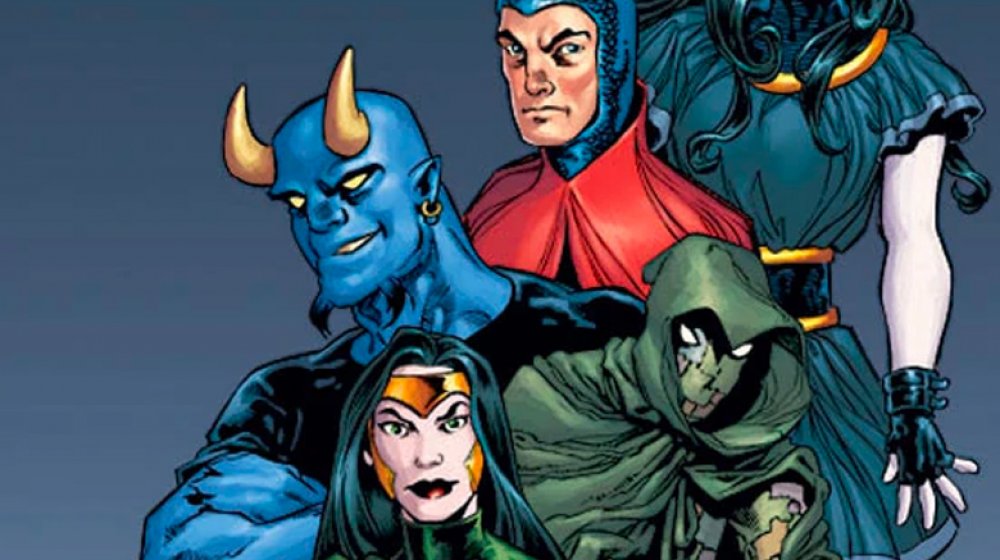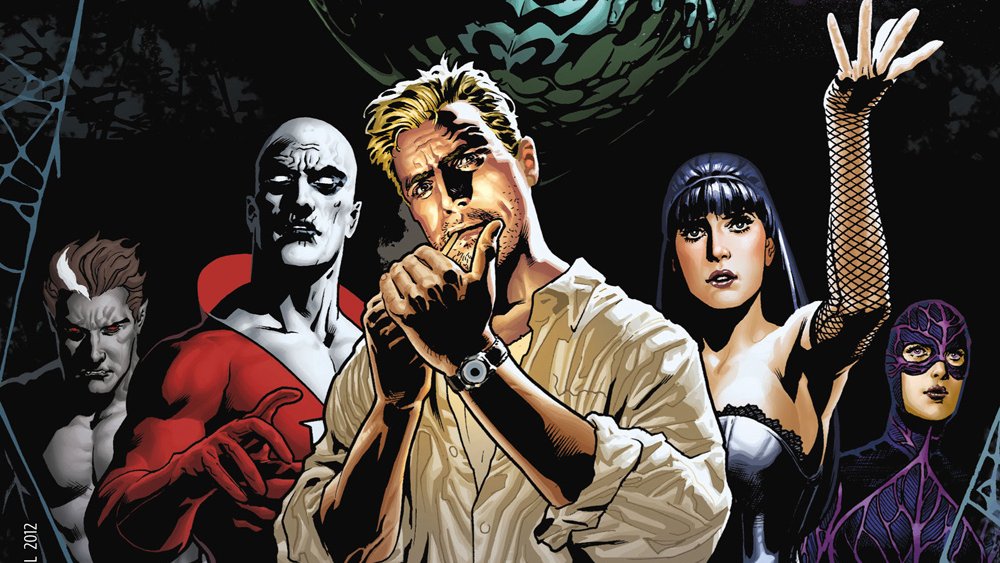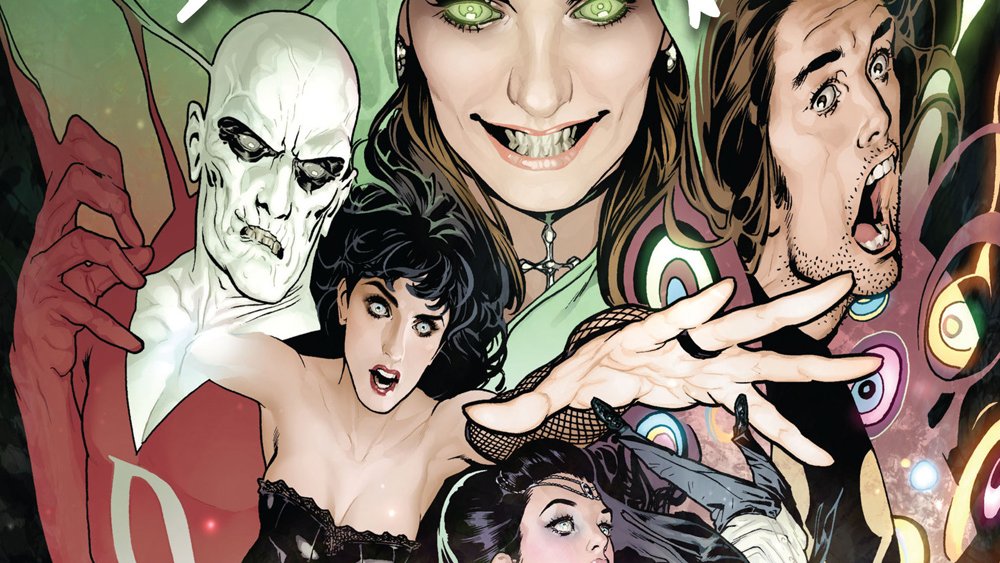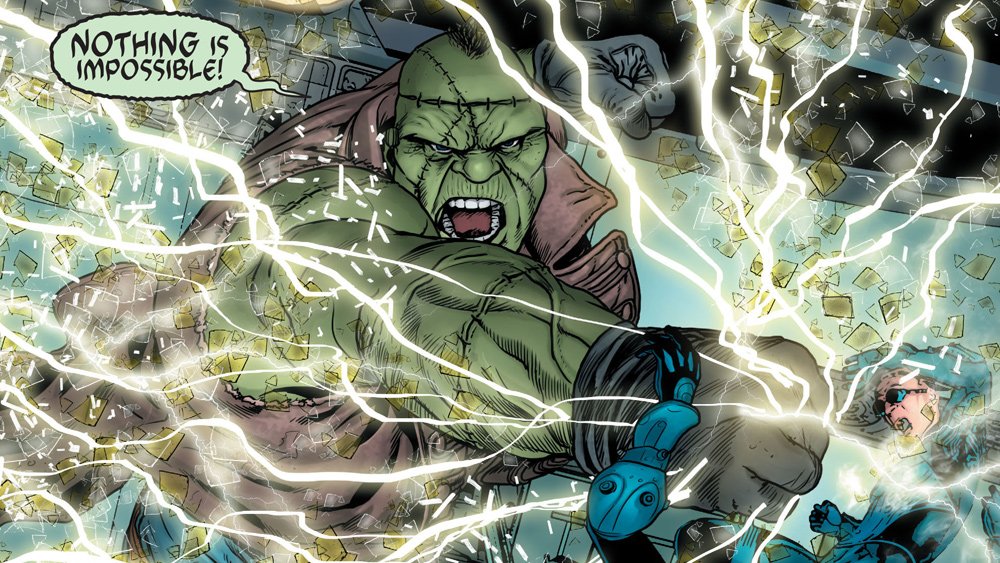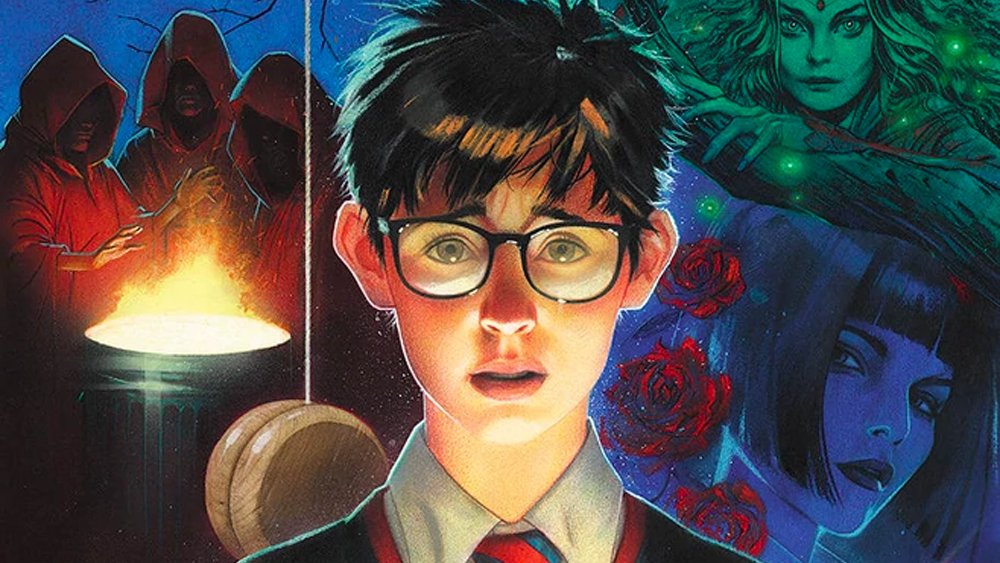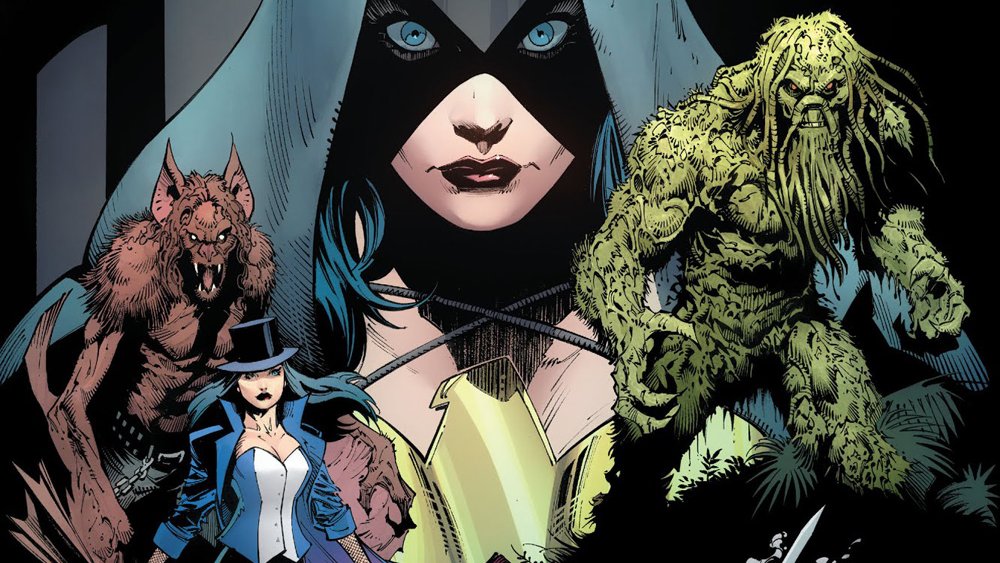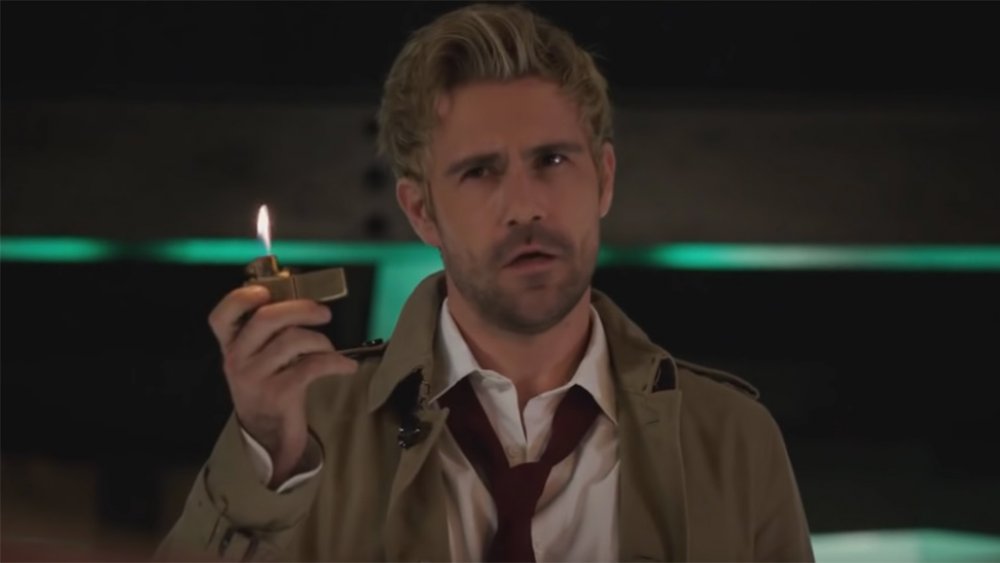The Untold Truth Of Justice League Dark
In the DC Universe, the Justice League has almost always been composed of the best, brightest, and most iconic superheroes: Superman, Batman, Wonder Woman, the Flash... and also Aquaman is usually in there for some reason. They're the champions who join together when the world, and sometimes even the entire universe, is threatened by the most powerful foes in existence, serving as the shining lights in the DCU's darkest hours.
Sometimes, though, there's a problem that can't be solved by the brightest lights. Supernatural threats like demons, vampires, and all the other twisted creatures of horror and magic that lurk in the shadows are out there, and while the Man of Steel and the Dark Knight might take them on occasionally, it's not their specialty. That's where the Justice League Dark comes in: a gathering of supernatural specialists that includes sorcerers, nature spirits, a certain Amazon warrior princess, and even the World's Greatest Detective, who in this case is an immortal talking monkey with a hat. Confused? The answers you seek lie below, in a digital tome of understanding that will reveal at last the untold truth of the Justice League Dark.
Mo' magic, mo' problems
It's never been their primary focus, but the Justice League has a pretty long history with magic that goes all the way back to the '60s. Some of their first major foes were evil wizards, like Felix Faust, who made his first appearance in the team's first year. His wicked spells — which, according to the comic, were accompanied by "the fumes of wizardry" — were fueled by a trio of demons named Abnegazar, Rath, and Ghast, who would stick around on the fringes of the DCU for years. He wasn't even the first evil spellcaster the team encountered, either. In Justice League of America #2, the JLA took on Simon Magus, who you might remember as the only evil wizard to show up in the Bible — Acts 8:9, if you're curious — making him one of the few characters to fight both the Apostle Peter and Batman.
In the '70s, Zatanna — who's both a stage magician and a genuine sorceress who casts her spells by speaking backwards —joined the team, and they've usually had some kind of magic specialist hanging around ever since. The various JLA rosters of the '90s even included both Zauriel and Etrigan, a literal angel and demon, respectively, with the former joining up in a story where Superman had to wrestle a renegade angel, Jacob style.
Even with all that, though, supernatural forces were never really the Justice League's primary focus. Part of that was purely born from necessity — vampires, demons, werewolves, and other spooky foes were expressly forbidden by the restrictive censorship of the comics code, By the time the cracks started appearing in the '70s, something that was much more noticeable across the street at Marvel with the launch of books like Tomb of Dracula and Werwolf by Night, ghosts and goblins just didn't seem to fit in with the rest of the JLA's deal. After all, Superman vs. Dracula is probably going to be a pretty short fight, what with one of those dudes being able to shoot solar-powered heat lasers out of his eyes.
Vertigo-a-Go-Go
By the '90s, with a new wave of horror comics becoming some of the most critically and financially successful books in DC's lineup, you might think that it would've been a pretty good time to do some more supernaturally themed titles with their superheroes. There were a few, of course. Some of the most notable came from Batman artist Kelley Jones, who had risen to fame with the cult favorite Batman: Red Rain, in which the Dark Knight fought Dracula and became a vampire. His run on the core Batman title was marked with a few suitably spooky guest appearances from the likes of Deadman, but overall, horror characters like Swamp Thing mostly stayed rooted (ha-ha!) in their own titles, separate from the larger DC Universe.
The reason had less to do with the stories themselves than it did with the publishing strategy, which kept DC's "Vertigo" imprint almost entirely separate from the main line of superheroes. While it would eventually grow so large that it encompassed every "Mature Readers" title that the company published, Vertigo — as its name implies — was originally intended to be the home of DC's horror comics.
Vertigo had been built around the success of Alan Moore and Steve Bissette's Swamp Thing and Neil Gaiman and Sam Keith's Sandman, but those books predated the imprint by several years. While many readers don't consider those to be superhero titles in the traditional sense, they started out firmly rooted in the DC Universe. Under Moore and Bissette, Swamp Thing fought Batman and Lex Luthor, and while it was certainly more disturbing than anything he'd done in his prior appearances, Dr. Destiny was the "villain" in one of early Sandman arcs. Once Vertigo was formalized, and started branching out into titles like Preacher, that were more horror-adjacent than anything else, a sort of wall went up between those titles and the regular DC Universe, ostensibly to keep the "mature" content from bleeding (ha-ha!) into books about kid-friendly characters like Superman.
While Swamp Thing might be the poster boy for this separation, John Constantine is probably the best example. He debuted in the DC Universe and even made an appearance in Crisis on Infinite Earths. Meanwhile, his own series, Hellblazer, had virtually no mentions of superheroes at all, and when the creators of DC titles like Firestorm wanted to use him, they had to come up with a substitute instead.
Shadows and pacts
In the mid-2000s, it seemed like it might finally be time for supernatural characters to make their presence felt on the superhero side of the DC Universe. There had been a few attempts before, including a late-'90s group of spooky titles called "Weirdoverse" that included a tragically short-lived comic called Scare Tactics, about a rock band that was made up of vampires, werewolves, and other monsters that traveled around getting into adventures. It was basically a reverse Scooby Doo, and it only lasted 12 issues, a concept that was truly ahead of its time. Eventually, though someone got around to the bright idea of taking some of the universe's existing heroes that were on the fringes of the supernatural, and team them up. It was sort of like the Justice League, but... dark.
It was called Shadowpact, and in all honesty, it was less like the Justice League and more like a magical version of the Suicide Squad — in fact, two of its members, Enchantress and Nightshade, were veterans of that team. The rest of the roster was rounded out mostly with relatively obscure characters who had never really fit in alongside the rest of the DC Universe. Ragman had debuted in a short-lived title the late '70s, a mystical vigilante with a suit made up of tattered rags that absorbed souls. Blue Devil had his own title in the '80s as a movie stuntman whose high-tech devil costume was cursed by an actual demon and permanently bonded with his body, only to become a real demon himself when he sold his soul to the devil in the '90s. Nightmaster was the most obscure by far, having had exactly four appearances in the previous 35 years, one of which was in 1969, with the remaining three in one of those short-lived '90s books that nobody read.
The breakout star of the book, however, also happened to be the World's Greatest Detective. No, the other one. Detective Chimp was, well, exactly what his name would suggest: a chimpanzee who escaped from the circus and drank from the fountain of youth, thus gaining incredible intelligence and a knack for solving crimes, and who originally appeared in the pages of Rex the Wonder Dog. That is quite possibly the most Silver Age DC Comics sentence ever written, but after being relegated to "remember how weird comics used to be?" discussions for about half a century, D.C. became a cult favorite. Who doesn't love a sarcastic mystery-solving monkey who told everyone he was smarter than Batman?
The League goes Dark
In 2011, DC rebooted their entire line, ending every single series they published — including the ones that had been running since the 1930s — and launching an all-new universe and 52 brand-new comics. One of the stated goals of the "New 52" was to diversify the line in terms of genre. While things were still pretty rooted in the superhero universe, revivals of titles like All-Star Western and I, Vampire, along with new stuff like the high fantasy Demon Knights, tried to blend everything together in a new way.
Of course, there was still room for three different Justice League titles. While two of them were pretty standard, with Justice League focusing on the heavy hitters and household names and Justice League International providing a home for the B-list, the third title was something different. It was, at last, Justice League Dark, continuing the style of adventures seen in books like Shadowpact, but now under a name that put it at the center of the DC Universe.
The book was launched with the creative team of Peter Milligan and Mikel Janin, both of whom were solid choices. Janin was a rising star who would go on to draw top-tier books like Batman, but Milligan was an established name with a history of mixing superheroes with more more mystical threats. He'd done plenty of horror at Vertigo, including a lengthy run on Hellblazer — not to mention some critically acclaimed books at Marvel, like X-Statix — but for core DC fans, he was probably best known for a 1990 Batman story called "Dark Knight, Dark City." In that creepy tale, Batman faced off against the Riddler, whose crimes went way beyond obvious clues and crossword puzzles when he was possessed by a demon called Barbatos that had been sealed away beneath Gotham City by an arcane ritual in the 18th century that involved Thomas Jefferson. For years, it was mostly thought of as a cult favorite, but by the end of the 2010s, it had actually become a foundational piece of the Batman mythos, with Barbatos at the center of long-running stories and massive DC Universe crossovers.
It was also exactly the sort of blend of superheroics and supernatural that Justice League Dark was promising to fans.
Familiar faces
At the launch of the New 52, the roster of Justice League Dark was made up of established characters, including a few that had only recently become fair game when relaunch obliterated the wall separating the Vertigo characters from the DC Universe. The original gathering of occult heroes was sparked when the Enchantress was separated from her human host, June Moone. She went mad, unleashing her reality altering magic on a worldwide scale and prompting several events that ranged from creepy to downright nightmarish, with a pretty distressing body count. Needless to say, the Justice League attempted to intervene, but after Superman had to deal with a tornado of rotten teeth, the League decided that maybe they better let someone else handle this one.
The "someone else" in this case was Zatanna, the backwards-talking spell-casting sorceress who'd been associated with the team since the '70s. By the time that first arc was through and the Enchantress was once again bound to June, the roster included a handful of characters who decided to stick around when Cain (of "and Abel" fame) woke up and started gathering an army of vampires.
Along with Zatanna, the team was anchored by John Constantine, the perpetually grumpy dirtbag sorcerer who was essentially like if Harry Potter grew up to be an unemployed chain-smoker whose only decisions were the bad ones. They were joined by Deadman, the ghost of a murdered circus acrobat who could possess living human bodies and grant them all the skills and social graces you'd expect from an undead carny. Next was Shade the Changing Man, an inter-dimensional weirdo with a hallucinogenic, super-powered vest that could alter reality. They were gathered together by Madame Xanadu, a tarot-reading seer who guided them on their missions with horrifying visions of the future.
New weirdos
Initially, the setup of Justice League Dark was that they were a "non-team" — a loose gathering of occult specialists who figured they'd go their separate ways as soon as there weren't so many Draculas causing a ruckus. Once it became clear that there was no shortage of supernatural threats to the universe, they became an official branch of the Justice League. While the team would continue to bring in characters who were strongly identified with the Vertigo line, there were also some relatively new faces.
The most notable new characters, for certain values of "new," included DC's version of Frankenstein's monster, who for the sake of expedience and/or making the more pedantic readers mad, was just called "Frankenstein." Originally introduced in 2008, DC's Frankenstein had been a traveling adventurer for nearly 200 years, battling various evil forces and swapping out his body parts, which at one point resulted in him getting the right arm (and flaming sword) of the archangel Michael. When he was introduced, Frankenstein was an agent of S.H.A.D.E., the Super-Human Advanced Defense Executive, which, despite the more generalized connotation of is name, mostly dealt with the monstrous side of things.
(Comic) Books of Magic
The other major addition, to both the team and to the DC Universe proper, was Tim Hunter. He wasn't exactly a new character, having been created by Neil Gaiman and John Bolton in 1990's Books of Magic, and going on to star in an ongoing series of the same name that ran for 75 issues.
The original idea behind Books of Magic, and the character of Tim Hunter, would be to create a story and a character that could unite all of DC's various mystical characters and update them into something new and, frequently, something ominous. As a result, Tim's adventures brought him into contact with all manner of weirdos, including Constantine, the Phantom Stranger, and even the supporting cast of Amethyst, Princess of Gemworld.
As for the character himself, Tim was a British schoolboy with glasses and an unruly mop of brown hair who discovered that he was the heir to a powerful magical destiny, and traveled to a world of sorcery that existed alongside the mundane. If those broad strokes sound extremely familiar to you, you're not the only one, but the details of Tim's life and a certain other bespectacled wizard boy from merry ole England are vastly different. When he was asked whether he thought he'd been ripped off, Gaiman told an interviewer, "I doubted she'd read it and that it wouldn't matter if she had: I wasn't the first writer to create a young magician with potential, nor was Rowling the first to send one to school."
Signs and Wonders
The first Justice League Dark series ended in 2015, but after a crossover called No Justice involved the team splitting into three smaller task forces to deal with a problem that threatened all of reality, the need for a branch focused on the mystical side of things was made apparent once again. Thus, a second run of Justice League Dark was launched with the creative team of James Tynion IV and Alvaro Martinez.
This time, though, the roster was led by one of the biggest names in the DC Universe, one with no shortage of familiarity with myth and magic: Wonder Woman. Under her leadership, the team was headquartered in a secret archive hidden half a mile below the Hall of Justice that contained, among other things, a complete skeleton of a dragon that clocked in around 50 feet tall. Zatanna stayed on as the connection to the previous version of the JLD — with John Constantine lingering in orbit in a supporting role — but the team also included Swamp Thing and Man-Bat, who, while not a supernatural creature, was still creepy enough to qualify.
They also recruited another hero with experience dealing with evil wizardry, who tied the book back to one of this idea's other previous incarnations: Detective Chimp. The book codified that some form of the Shadowpact had existed in the new universe, and that after the Nightmaster died, he passed his sword and his title down to D.C., making him a superintelligent crime-solving chimpanzee with a magic sword and a drinking problem. With that combination of the core DC Universe (Wonder Woman), the weirder side of superheroes (Detective Chimp), the Vertigo horror icons (Swamp Thing and Constantine) and a character who had served as the connection between all three (Zatanna), the Justice League Dark finally brought all of DC's supernatural sections together as a unified whole.
The curse of cancellation?
With its combination of superheroes and the spooky horror elements that genre fans crave, Justice League Dark seems like one of the easiest concepts to sell to a wider audience. And yet, despite having all of that going for it, when it comes to hitting the big and small screens, the team has struggled.
A Justice League Dark movie, or at least something with a similar take, was announced as far back as 2013, when Guillermo del Toro — the Academy Award-winning director of The Shape of Water, Pan's Labyrinth, Hellboy and other fantastic, monstrous films — confirmed that he was working on developing one. Obviously, that hasn't happened, with the stutter-steps of the DC superhero movies and the debut and cancellation of the Constantine TV series, and by 2015, del Toro was no longer attached.
There were also plans to bring the JLD to television, but unfortunately for them, the shows they were planned to appear on kept getting canceled. First was Constantine, which was planned from the start to introduce the team with hopes of spinning them off into their own series, but got the axe after a single season. A few years later, the exact same thing, right down to the spinoff plans, happened with the DC Universe streaming show Swamp Thing. Still, the prominence of the team in comics has only increased over the years, and with the sprawling nature of the Arrowverse on a network that has always embraced the supernatural, it's hard to imagine that there won't at least be a TV show at some point in the future... eventually.
In the meantime, the closest we've gotten is probably the CW series Legends of Tomorrow, in which Matt Ryan returned as Constantine to help a team of obscure DC characters battle increasingly bizarre threats, like a demon that they could only defeat by channeling mystical energy into a 12-foot tall teddy bear. It's not quite Justice League Dark, but it'll do in a pinch.
